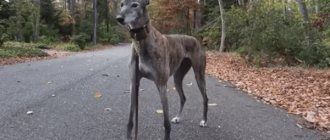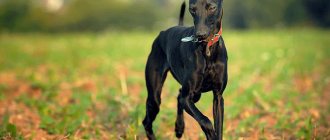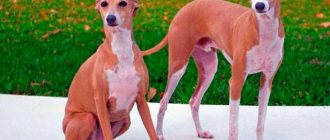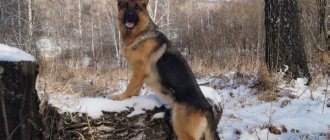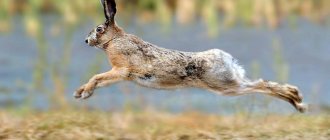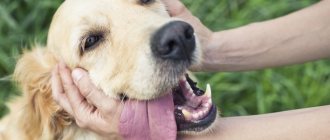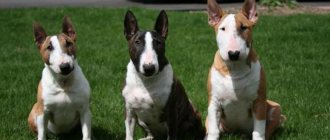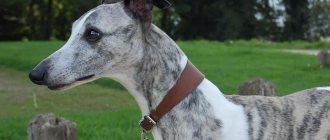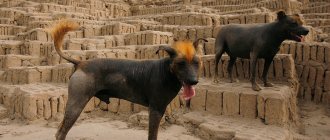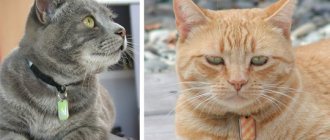Greyhounds are famous for their speed. Previously, they were specially kept at royal courts for hunting deer, rabbits and hares. It was not at all difficult for the dog to catch the nimble game in a couple of seconds. Now these dogs are no longer bred for hunting purposes. Owners value their greyhounds for their incredible grace and great intelligence. Although the ability to accelerate to enormous speeds does not go unnoticed - representatives of the breed are used in “greyhound racing” (greyhound racing is one of the favorite events in the UK).
- 2 Appearance standards
2.1 Video: Greyhounds in motion - 2.2 Photo gallery: colors acceptable for greyhounds
- 6.1 How much do greyhounds cost?
History of the breed
Greyhounds are also called English or British greyhounds, but despite this name the breed did not originate in Great Britain. The birthplace of dogs is Ancient Egypt. Around the 3rd century BC, dogs were transported from the African continent to Eastern Europe (presumably this was done by the Celts, who served as mercenaries for the rulers of the Egyptian Ptolemaic dynasty). In the 10th century AD, greyhounds were brought to Great Britain, and it was here that these dogs became real “stars”.
The Greyhound is a slender, strong and flexible dog.
Initially, the English elite kept greyhounds to hunt fast-running animals. Dogs easily accelerate to 50 km/h (and trained dogs can overcome the 60 km mark). Such four-legged “meteors” are capable of catching up with a racing deer, fox, rabbit, hare. By the way, the British nobility believed that if ordinary people were allowed to keep such fast dogs, they would soon catch all the game. That is why in 1014 the Forest Law stated that ordinary peasants were strictly forbidden to keep greyhounds.
Since the 18th century, coursing has become popular in Great Britain - a competition between two or more greyhounds set off after a hare. At first, the race was held in open areas (in forests, fields), but then they began to equip special stadiums where spectators could watch the process of the chase from beginning to end. In the 1920s, baiting of animals began to be prohibited, so the public was offered a new type of entertainment - greyhounds running along a looped track for a mechanical bait.
Greyhounds running for live prey is prohibited; a mechanical bait is used (a plush hare attached to a car moving quickly along the track)
Greyhound racing is still common in the UK. The English love this dog sport almost as much as they love horse racing. There are 28 stadiums in the country that specialize in daily racing of these greyhounds. More than 3 million people visit such stadiums every year.
The highest speed for dogs was recorded on March 5, 1994 in Australia, when a greyhound named Star Title reached a speed of 67.32 km/h
Greyhounds are officially recognized by all canine associations. The American and English Kennel Clubs (KC and AKC) included the British Greyhound as a breed back in 1885. The dogs were added to the FCI classification in April 1955. The modern breed standard was published in 2011.
Puppies
When purchasing a Greyhound breed, whose puppies are not at all similar to an adult dog, you should answer the question: are you ready to put up with all the pranks of the baby. After all, an English greyhound puppy is overly active, fussy, even rowdy and requires increased attention. This is when they grow up, become measured, proud and calm.
Once in a new home, puppies easily adapt to the conditions, and the owner will only have to teach him “good manners”: introduce him to the sleeping area, the rules in the house and in the family. When choosing a puppy, you should decide for what purpose you are getting it. Within the breed, there are several types of Greyhounds, which are used for different purposes:
- hunting dogs used to catch game. Adult greyhounds of this type are distinguished by powerful bones, high speed, agility, agility, strength and endurance;
- racing dogs – for running after mechanical bait. They have short stature, lean constitution and light weight - everything they need to develop record speed on the track;
- show dogs are future champions at shows. They look very colorful and fully comply with the standard, they are distinguished by a harmonious physique, grace and expressiveness.
Agility, the ability to develop great speed, loyalty and sensitivity are characteristic of all types of greyhounds; all of them will be a good companion for the owner.
Character Standards
Greyhounds are very smart dogs. They quickly understand what a person wants from them and carry out commands without whims. The dog tries in every possible way not to anger its owner. Showing character by trying to dominate the house is not the style of English greyhounds. The main character traits of dogs is their friendliness. They love affection, they always climb under your hands to be petted.
The animal is active, but only if it is allowed to run and jump. Without commands, greyhounds will not chase around the yard or park after the prey they like. In the house they behave like real aristocrats - they like to sleep or calmly watch their household members from a lying position.
At home, greyhounds love to lie on a soft surface, so they need to arrange their own personal beds, otherwise the dogs will climb onto chairs and sofas
At first they behave warily towards strangers (both animals and people), but do not show aggression. They adapt to strangers quickly - as soon as they understand that their owner is friendly towards the stranger, they will immediately come up to introduce themselves.
Watchmen and guards from greyhounds turn out to be useless. These are companion dogs with a very friendly character. They will not bark or attack aggressors (their first defensive reaction in case of danger is to run and hide). They get along well with children. They take part in common games with pleasure. They get along easily in the same house with other pets.
English greyhounds do not tolerate loneliness and love company, so it is recommended to have greyhounds in pairs
Feeding
The special structure of the greyhound's body contributes to its accelerated metabolism. Especially when the animal is exposed to physical activity: running, chasing, doing exercises. Hounds need a nutritious, balanced diet to maintain health.
Puppy
When feeding young animals, adhere to the following rules:
- Portions should be small - the animal is just getting used to the food. Increase the amount of food as your pet grows.
- The puppy should eat in a quiet place without extraneous noise or distracting movements.
- To help your baby get used to eating in the same place, set aside a special corner for meals - always place food there. The same dishes also contribute to habituation.
Dog food bowls
After eating, keep the animal calm - too active actions contribute to intestinal volvulus and regurgitation.
What foods should be included in the diet of a growing organism?
- dietary meat;
- low-fat milk;
- boneless fish;
- eggs;
- low-fat cottage cheese;
- porridge;
- vegetables.
Example of a puppy's diet
Don't forget about vitamin complexes and supplements of useful minerals. If you want to introduce your animal to food, consult your veterinarian to choose the best products.
Adult Greyhound
Divide meals into 4-6 meals per day for the animal - there should not be too much food in the bowl. Give preference to healthy natural products:
- lean meat and offal (heart, liver);
- eggs;
- boneless fish;
- porridge;
- dried pieces of bread;
- vegetables and fruits.
Adult Greyhound Foods
It is recommended to pre-clean the meat of fat. It is better to exclude pork from the diet - pay attention to chicken, turkey, rabbit, and game. Be sure to alternate meat with other products - it does not contain all the beneficial substances a dog needs. Porridge and bread should be of such a consistency that the animal can easily swallow them.
Important! Avoid long bones: their fragments can damage the oral cavity and digestive system. But you can give your dog harder bones - they help clean the teeth.
For what disqualifications can a dog be rejected?
To obtain a certificate from the canine society for participation in exhibitions and breeding of the breed, you must undergo an examination for compliance with standards. There are “non-strict” deviations, in which the document will not be refused, but the dog will be classified as a breeding class (the price of puppies will decrease significantly, the chances of winning in competitions are low).
A show-class Greyhound, that is, meeting all breed standards, can take part in exhibitions
Here is a list of strict disqualifications (reasons why a Greyhound will not be able to take part in exhibitions and participate in breeding):
- violation of the sexual type (too large bitch or too light male);
- excessive aggressiveness towards humans and other dogs;
- excessive cowardice;
- too short blunt muzzle and rounded cranial part of the head;
- snack or undershot;
- tail too short;
- long wool;
- short legs;
- blue or green eyes, light nose with spots.
The puppy can have blue and gray eyes, but by the age of one year they should darken
What kind of people is an English Greyhound suitable for?
Despite the calm nature, we must not forget that this is a sports dog. She by nature needs to move a lot. Those who do not have the desire and time for long walks should not own Greyhounds. Dogs of this breed should spend at least 3 hours a day outdoors. Each walk should give the greyhound an opportunity to “flex its muscles” - it should run and jump. Without such training, the greyhound will begin to lose shape and quickly gain weight.
The best type of training for greyhounds is chasing and taking away prey (in the photo, a stuffed hare appears as a “victim”)
Human running records pale in comparison to those set by greyhounds. Usain Bolt set the 100m world record by 9.58 seconds. The Greyhound covered the same distance in 5.02 seconds. Michael Johnson holds the 400m record in 43.18 seconds, significantly slower than the Greyhound, who runs it in 21.10 seconds. David Rudisha's 800-meter record of 1 minute and 41 seconds pales in comparison to the Greyhound's 50 seconds. Record holder Hicham El Guerrouj, who ran 1500 m in 3 minutes 26 seconds, is just a turtle compared to 1 minute 43 seconds for the English greyhound.
Crazy Zoologist
https://forum.zoologist.ru/viewtopic.php?id=4972&p=2
Features of care and maintenance
This is a domestic dog and is not suitable for kennel keeping. Unpretentious, easily adapts to any conditions. The Greyhound can be kept in a city apartment, although it feels better in a private house with a large plot. If the dog walks around the territory on its own, a high fence is necessary - greyhounds jump well.
Despite its large size, an adult Greyhound will not be noticeable at home. But on the street he is an energetic and playful dog. He definitely needs physical activity and walking 2 times a day for at least 1-2 hours. During a walk, he should run: after a ball, a stick, or accompany a bicycle. It is recommended to take your pet out into nature more often or to dog parks. In the city it is better not to let him off the leash - he might run after the cat and get hit by a car.
It should be taken into account that representatives of this breed have almost no undercoat; thin short hair does not protect against the cold. Therefore, it is advisable to wear insulated overalls when walking in winter, and waterproof ones when it rains.
Hygiene procedures
Caring for these dogs is easy. If a puppy is taught hygiene procedures from an early age, they will not cause problems:
- comb the coat with a soft brush or rubber glove 2 times a week; it is better not to use combs and a furminator;
- bathe as needed, preferably no more than once every few months;
- after walks, wash your paws and belly;
- check and, if necessary, wash eyes;
- check your ears every week and clean them of wax;
- it is important to trim the nails regularly; as they grow back, they will not only bother the dog, but can cause injury;
- To prevent tartar, brush your teeth several times a month with a special paste or regularly give chewable treats.
Nutrition
These dogs love to eat, but should not be overfed. With a lack of exercise, they quickly gain weight. You especially shouldn’t feed a lot if the pet doesn’t hunt, doesn’t race, and lives in the city. On average, a dog eats 400 g of food per day. This amount should be divided into two doses - the greyhound has a small stomach. Nutrition should be balanced, rich in protein. You can feed your pet dry food or natural food.
When feeding ready-made food, it is necessary that it be at least super-premium class. Representatives of the breed are prone to food allergies. It is important to study the composition; it should not contain soy or artificial additives. At least 50% should be meat. It is advisable that the food is specifically designed for hunting dogs.
When choosing a natural diet, the dog is fed porridge with meat. Chicken, beef, rabbit are suitable; it is better to choose pieces with cartilage and veins. It is recommended to boil the cereals in meat broth. Several times a week you can give offal, sea fish, eggs. Vegetables, herbs, and dairy products are healthy.
You should not give Greyhounds food from your table, salty or spicy foods. Legumes, sweets, and smoked foods are contraindicated for them. You cannot feed pork or river fish. Adult dogs are not given milk.
Health
These dogs have a short life expectancy. On average they live 9-11 years. But they have fairly good health. Sometimes representatives of the breed have the following congenital and acquired diseases:
- arthritis;
- deafness;
- eye diseases;
- allergy;
- hypothyroidism
If your dog is sick, you should contact a veterinarian. Greyhounds are very sensitive to medications and do not tolerate anesthesia well.
How to care for a dog
As for a true athlete, a clear daily routine, proper nutrition and regular physical activity are important for greyhounds. You should walk your dogs for 3-4 hours a day (can be divided into sessions of 30-40 minutes, 2-3 hours apart). During walks, you should give the dog a good run - the best option is to throw its “prey” (a ball, a plush toy).
After active games, the dog needs to replenish the fluid spent on activity (Greyhounds drink a lot, so constant access to clean water is a prerequisite). It is better to feed greyhounds with special food for large dogs with increased activity (for example, Royal Canin Sporting Life Trail, Hill's Science Plan Performance, Purina Dog Chow Active, Babin Tonivet Sport are suitable for greyhounds).
Greyhounds' coat is not fussy. Dogs should be washed when they become dirty. It is enough to comb 3-4 times a week, using a brush with soft bristles. Attention must be paid to the claws - they should always be trimmed short so that during a fast run they do not break off and injure the paw pads.
Due to the lack of a dense fat layer and the long coat of greyhounds, it is necessary to insulate them in the cold season
Mating
For mating, you need to find a partner of the same content category. The process should take place in a familiar environment for the dog. It is best to breed dogs after the female's third heat, which occurs at approximately 2 years of age .
It would be appropriate to first let the dogs get to know each other better and go through the entire courtship process.
Since dogs are very shy, it is necessary to leave them alone. This breed is very delicate. Typically the process takes from 20 minutes to an hour . Breeders need to look at their pets from time to time. This is necessary so that during the “lock” the dogs do not harm each other.
Do Greyhounds have a tendency to get sick?
The average life expectancy of dogs of this breed is 10–13 years. Hereditary defects are extremely rare; greyhounds are considered animals with good health. Rarely, hereditary autoimmune pathologies, retinal atrophy, displacement of the patella, and Perthes disease are possible. Many of these diseases manifest themselves over time, so it is better to immediately take the puppy to the veterinarian and examine him for possible abnormalities.
The active lifestyle of a greyhound has its own dangers - at high speed, the dog can trip on a bump or crash into an obstacle and get injured. Owners need to keep an eye on their pet - if a greyhound limps after a walk, licks its paws, whines, or lumps appear on its body, then the animal should be taken to a veterinarian and checked for bruises, fractures, and dislocations.
Color
Greyhound puppies come in a variety of colors. Animals found:
- black;
- white;
- redheads;
- red;
- fawn;
- yellowish and brindle shades of fur.
In addition, the standard allows a “diluted” color - any of the colors listed above on a white background.
